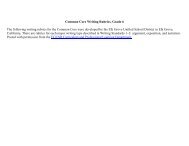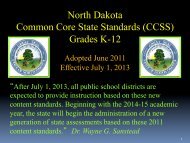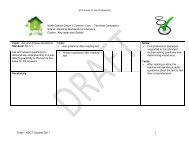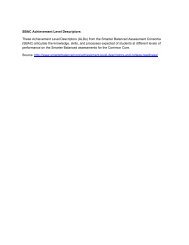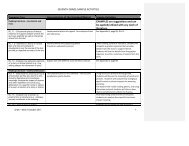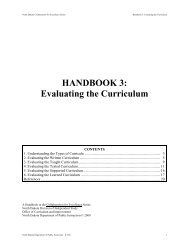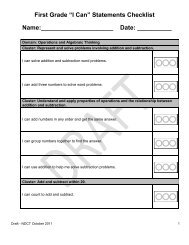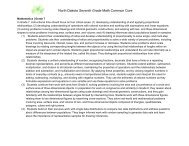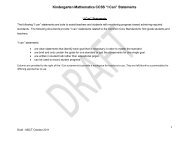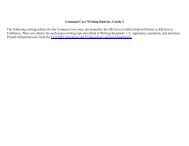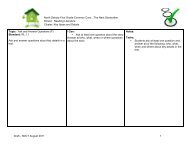A. ND Mathematics Content Standards, Grade 5 - ND Curriculum ...
A. ND Mathematics Content Standards, Grade 5 - ND Curriculum ...
A. ND Mathematics Content Standards, Grade 5 - ND Curriculum ...
You also want an ePaper? Increase the reach of your titles
YUMPU automatically turns print PDFs into web optimized ePapers that Google loves.
5.MD.5<br />
Relate volume to the operations of multiplication and addition and solve real world<br />
and mathematical problems involving volume.<br />
a. Find the volume of a right rectangular prism with whole-number side lengths<br />
by packing it with unit cubes, and show that the volume is the same as would<br />
be found by multiplying the edge lengths, equivalently by multiplying the<br />
height by the area of the base. Represent threefold whole-number products<br />
as volumes, e.g., to represent the associative property of multiplication.<br />
b. Apply the formulas V = l × w × h and V = b × h for rectangular prisms to find<br />
volumes of right rectangular prisms with whole-number edge lengths in the<br />
context of solving real-world and mathematical problems.<br />
c. Recognize volume as additive. Find volumes of solid figures composed of two<br />
non-overlapping right rectangular prisms by adding the volumes of the nonoverlapping<br />
parts, applying this technique to solve real world problems.<br />
Domain: Geometry 5.G<br />
Cluster: Graph points on the coordinate place to solve real-world and mathematical problems.<br />
Code <strong>Standards</strong> Annotation<br />
5.G.1 Use a pair of perpendicular number lines, called axes, to define a coordinate<br />
system, with the intersection of the lines (the origin) arranged to coincide with the 0<br />
on each line and a given point in the plane located by using an ordered pair of<br />
numbers, called its coordinates. Understand that the first number indicates how far<br />
to travel from the origin in the direction of one axis, and the second number<br />
indicates how far to travel in the direction of the second axis, with the convention<br />
that the names of the two axes and the coordinates correspond (e.g., x-axis and x-<br />
coordinate, y-axis and y-coordinate).<br />
5.G.2<br />
Represent real world and mathematical problems by graphing points in the first<br />
quadrant of the coordinate plane, and interpret coordinate values of points in the<br />
context of the situation.<br />
Cluster: Classify two-dimensional figures into categories based on their properties.<br />
Code <strong>Standards</strong> Annotation<br />
5.G.3<br />
Understand that attributes belonging to a category of two-dimensional figures also<br />
belong to all subcategories of that category. For example, all rectangles have four<br />
right angles and squares are rectangles, so all squares have four right angles.<br />
5.G.4<br />
Classify two-dimensional figures in a hierarchy based on properties.<br />
North Dakota <strong>Mathematics</strong> <strong>Content</strong> <strong>Standards</strong><br />
Based on the Common Core State <strong>Standards</strong><br />
<strong>Grade</strong> 5 15 June 2011



